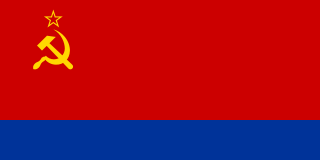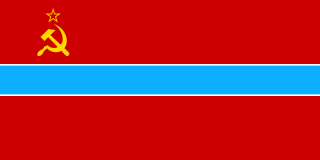
The flag of the Estonian Soviet Socialist Republic was officially adopted by the former Soviet Union in 1940. It showed a set of Communist symbols: a yellow hammer and sickle on a red field and, after official change of the flag's design in 1953, also an outlined yellow star, above a band of water waves near the bottom.

The State Flag of the Union of Soviet Socialist Republics, or simply the Soviet flag, was a red banner with two communist symbols displayed in the canton: a gold hammer and sickle topped off by a red five-point star bordered in gold. The flag's design and symbolism are derived from several sources, but emerged during the Russian Revolution. It has also come to serve as the standard symbol representing communism as a whole, recognized as such in international circles, even after the dissolution of the Soviet Union in 1991.

The hammer and sickle is a communist symbol representing proletarian solidarity between agricultural and industrial workers. It was first adopted during the Russian Revolution at the end of World War I, the hammer representing workers and the sickle representing the peasants.

The national flag of the Russian Federation is a tricolour of three equal horizontal fields: white on the top, blue in the middle, and red on the bottom. It was first raised in 1696, as an ensign for merchant ships under the Tsardom of Russia.

The state flag of Belarus is a red-green bicolour with a red-on-white ornament pattern placed at the hoist (staff) end. The current design was introduced in 2012 by the State Committee for Standardisation of the Republic of Belarus, and is adapted from a design approved in a May 1995 referendum. It is a modification of the 1951 flag used while the country was a republic of the Soviet Union. Changes made to the Soviet-era flag were the removal of communist symbols – the hammer and sickle and the red star – as well as the reversal of the colours in the ornament pattern. Since the 1995 referendum, several flags used by Belarusian government officials and agencies have been modelled on this national flag.

The national flag of Kazakhstan, also called the Kazakh flag, was adopted on 4 June 1992, replacing the flag of the Kazakh Soviet Socialist Republic. The flag was designed by Shaken Niyazbekov.

The national flag of Lithuania consists of a horizontal tricolour of yellow, green, and red. It was adopted on 25 April 1918 during Lithuania's first period of independence from 1918 to 1940, which ceased with the occupation first by the Soviet Union, and then by Nazi Germany (1941–1944). During the post-World War II Soviet occupation, from 1945 until 1988, the Soviet Lithuanian flag consisted first of a generic red Soviet flag with the name of the republic, in 1953 that was changed to the red flag with white and green bands at the bottom.

The flag of the Azerbaijan Soviet Socialist Republic was a plain red flag with a golden hammer and sickle and a gold-bordered red star in its upper canton and an horizontal dark blue band on the bottom fourth, representing the Caspian Sea.

The Flag of the Byelorussian Soviet Socialist Republic was adopted on 25 December 1951. Prior to this, the flag was red with the Cyrillic characters БССР (BSSR) in gold in the top-left corner, surrounded by a gold border. Between 1937 and the adoption of the above flag in the 1940s, the flag was the same, but with a gold hammer and sickle above the Cyrillic characters and no border. Between 1919 and 1937, the flag was red, with the Cyrillic characters ССРБ (SSRB) in the top left-hand corner. In early 1919, a plain red flag was used. The final BSSR flag was used until the collapse of the Soviet Union in 1991. A flag based on this Soviet design is used as the national flag of Belarus.

The flag of the Kazakh Soviet Socialist Republic was adopted by the Kazakh government on 24 January 1953. The flag resembles the flag of the Soviet Union in defaced form with a 2/9 horizontal blue (azure) bar in the lower part of the flag and the hammer and sickle in the near centre.

The flag of the Kirghiz SSR was adopted by the Presidium of the Supreme Council of the Kirghiz SSR decreed by its Decree on 22 December 1952. The 1978 constitution of the Kirghiz SSR states that the ratio of the flag is 1:2 with the blue/white/blue stripes in the middle taking 1⁄3 of the flag height and the white stripes 1⁄20 of flag height. The red, blue and white colors were derived from the Pan-Slavic colours.

The flag of the Moldavian Soviet Socialist Republic was adopted on 31 January 1952. The flag has three horizontal bands of red, green (1/4) and red, with a hammer and sickle in the canton. As defined by the Presidium of the Supreme Soviet of the Moldavian Soviet Socialist Republic on the flag description:
The national flag of the Moldavian Soviet Socialist Republic consists of a panel of red color with a green stripe in the middle of the whole flag length, with the image on top of the red part of the flag from the flagpole golden hammer and sickle above a five-pointed red star framed by gold border. The ratio of the flag's width to its length is 1:2 with the bandwidth of green to the width of the flag 1:4

The flag of the Tajik Soviet Socialist Republic was the red Soviet flag with white and green stripes below the gold hammer and sickle, with the measures: 1/2 red, 1/5 white, 1/10 green, 1/5 red. The flag sported the Pan-Iranian colors of red, white and green, as a nod to the republic's Persian-descended culture. The flag was adopted on March 20, 1953 by decree of the Supreme Soviet of the Tajik SSR:
The national flag of the Tajik Soviet Socialist Republic is a panel consisting of four horizontal colored stripes: the upper band of red which is half the width of the flag; white stripe, making one fifth of the width of the flag; green stripes, is one-tenth the width of the flag, and the lower band of red color, is one-fifth the width of the flag. On top of the red band at the flagpole located gold hammer and sickle and above them is a five-pointed red star framed by a gold border. The ratio of the flag's width to its length is 1: 2.The fitting of the hammer and sickle into a square whose side wound 1/4 width of the flag. The sharp end of the sickle falls in the middle of the upper side of the square, handles the sickle and hammer rest on the bottom corners of the square. hammer with a handle length is 3/4 of the diagonal of a square. The five-pointed star in a circle fits 1/8 width of the flag relating to the upper side of the square. Distance vertical axis of the star, the hammer and sickle from the grapnel is equal to 1/4 of the flag's width. The distance from the top edge of the flag of the flag to the center of the star - 1/10 of the flag's width.

The flag of the Turkmen Soviet Socialist Republic was adopted by the Turkmen SSR on August 1, 1953. Although similar to the Flag of the Soviet Union, the layout is identical to the flag of the Kirghiz SSR with a ratio of 1:2. The two blue stripes between the red represents the rivers Amu Darya and Syr Darya, the red represents the "revolutionary struggle of the working masses", the hammer and sickle represents the peasants' and workers' union, and the red star is the symbol of the ruling Communist Party.

The first flag of the Ukrainian Soviet Socialist Republic (UkSSR) was adopted on 10 March 1919 to serve as the symbol of state of the Ukrainian SSR. Details of the official flag changed periodically before the collapse of the Soviet Union in 1991, but all had as their basis the communist red flag. According to the decree of the Presidium of Supreme Soviet of Ukrainian SSR on 21 November 1949, the blue in the bottom "symbolises the mightiness and beauty of the people, and the blue banner of Bohdan Khmelnytsky".

The flag of the Uzbek SSR was adopted by the Uzbek SSR on 29 August 1952. The red represents the "revolutionary struggle of the working masses", the hammer and sickle represents the peasants' and workers' union, and the red star is the symbol of the communist party. There is no official explanation for the symbolic meanings of other elements. However, in some material the white stripes represent cotton, the blue band represents Amu Darya and irrigation in general.

The flag of the Republic of Karelia is the official state symbol of the Republic of Karelia. Adopted by the Supreme Council of the Republic of Karelia on February 16, 1993. The flag was designed by Alexander Ivanovich Kinnear.
Transnistria is a region in Eastern Europe that is under the effective control of the Russian-backed Pridnestrovian Moldovan Republic but is recognized by the international community as an administrative unit of Moldova, the Administrative-Territorial Units of the Left Bank of the Dniester. The flag of the Prinestrovian Moldovan Republic is a red-green-red triband, while the Administrative-Territorial Units of the Left Bank of the Dniester use the flag of Moldova.

The flag of the Karelo-Finnish SSR was adopted by the Karelo-Finnish SSR on 3 March 1953. This flag is similar to the flag of the Soviet Union but with the blue, and green placed on the bottom. At the top of the flag at the flagpole placed golden hammer and sickle and the red star with a gold border. The green color symbolizes the forest resources, and blue represents the abundance of rivers and lakes.

The flag the Chuvash Autonomous Soviet Socialist Republic was adopted in 1954 by the government of the Chuvash Autonomous Soviet Socialist Republic. The flag is identical to the flag of the Russian Soviet Federative Socialist Republic.


























